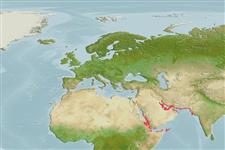Common names from other countries
>
Blenniiformes (Blennies) >
Blenniidae (Combtooth blennies) > Salariinae
Etymology: Atrosalarias: Latin, atro = black + Latin, salar, salaris = trout (Ref. 45335).
More on author: Rüppell.
Issue
Two subspecies: A. fuscus fuscus (Red sea and Indian Ocean) and A. fuscus holomelas (Pacific) (Ref. 90102).
Environment: milieu / climate zone / depth range / distribution range
Ecología
marino asociado a arrecife; rango de profundidad 2 - 12 m (Ref. 90102). Tropical; 30°N - 11°N, 28°E - 69°E
Indo-Pacific Ocean: including the Red Sea.
Tamaño / Peso / Age
Maturity: Lm ? range ? - ? cm
Max length : 14.5 cm TL macho / no sexado; (Ref. 90102)
Short description
Claves de identificación | Morfología | Morfometría
Espinas dorsales (total) : 9 - 11; Radios blandos dorsales (total) : 18 - 20; Espinas anales: 2; Radios blandos anales: 18 - 20; Vértebra: 33 - 35.
Adults inhabit sheltered, shallow reefs, hiding among live or dead coral branches (Ref. 1602). From estuaries to outer reef lagoons (Ref. 48636), 2-12 m deep. Solitary (Ref. 90102). Oviparous. Eggs are demersal and adhesive (Ref. 205), and are attached to the substrate via a filamentous, adhesive pad or pedestal (Ref. 94114). Larvae are planktonic, often found in shallow, coastal waters (Ref. 94114).
Life cycle and mating behavior
Maturities | Reproducción | Spawnings | Egg(s) | Fecundities | Larva
Oviparous, distinct pairing (Ref. 205).
Hastings, P.A. and V.G. Springer, 2009. Recognizing diversity in blennioid fish nomenclature (Teleostei: Blennioidei). Zootaxa 2120:3-14. (Ref. 82814)
IUCN Red List Status (Ref. 130435)
CITES (Ref. 128078)
Not Evaluated
Threat to humans
Harmless
Human uses
Herramientas
Special reports
Download XML
Fuentes de Internet
Estimates based on models
Preferred temperature (Ref.
115969): 24.9 - 29.3, mean 27.2 (based on 214 cells).
Phylogenetic diversity index (Ref.
82804): PD
50 = 0.6250 [Uniqueness, from 0.5 = low to 2.0 = high].
Bayesian length-weight: a=0.00871 (0.00463 - 0.01638), b=3.03 (2.86 - 3.20), in cm Total Length, based on LWR estimates for this species & (Sub)family-body (Ref.
93245).
Nivel trófico (Ref.
69278): 2.0 ±0.00 se; based on food items.
Resiliencia (Ref.
120179): Alto, población duplicada en un tiempo mínimo inferior a 15 meses (Preliminary K or Fecundity.).
Fishing Vulnerability (Ref.
59153): Low vulnerability (10 of 100).
